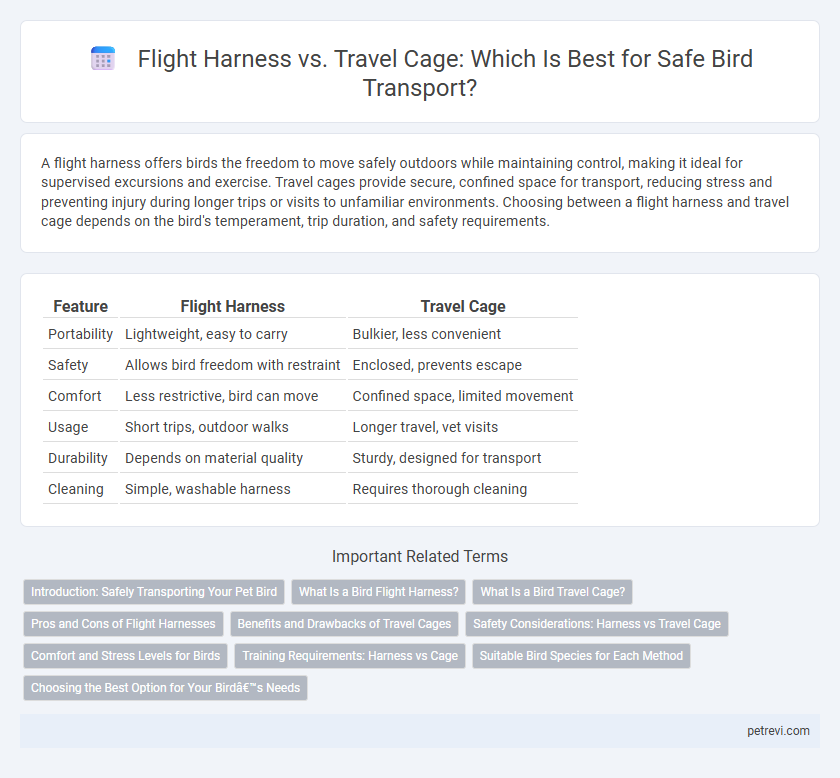A flight harness offers birds the freedom to move safely outdoors while maintaining control, making it ideal for supervised excursions and exercise. Travel cages provide secure, confined space for transport, reducing stress and preventing injury during longer trips or visits to unfamiliar environments. Choosing between a flight harness and travel cage depends on the bird's temperament, trip duration, and safety requirements.
Table of Comparison
| Feature | Flight Harness | Travel Cage |
|---|---|---|
| Portability | Lightweight, easy to carry | Bulkier, less convenient |
| Safety | Allows bird freedom with restraint | Enclosed, prevents escape |
| Comfort | Less restrictive, bird can move | Confined space, limited movement |
| Usage | Short trips, outdoor walks | Longer travel, vet visits |
| Durability | Depends on material quality | Sturdy, designed for transport |
| Cleaning | Simple, washable harness | Requires thorough cleaning |
Introduction: Safely Transporting Your Pet Bird
Choosing the right method for safely transporting your pet bird is crucial to ensure its comfort and security. Flight harnesses offer birds the freedom to experience the surroundings while preventing escape, making them ideal for short, supervised outdoor trips. Travel cages provide a secure and enclosed environment, best suited for longer journeys or situations requiring maximum protection during transit.
What Is a Bird Flight Harness?
A bird flight harness is a specially designed strap system that securely fits around a bird's body to allow safe outdoor flight or controlled movement during transport. Made from lightweight, durable materials, it prevents escape and reduces injury risk by limiting the bird's range of motion while providing comfort and freedom of wing movement. Unlike travel cages, flight harnesses offer birds direct exposure to the environment, making them ideal for supervised outdoor activities and short trips.
What Is a Bird Travel Cage?
A bird travel cage is a specially designed enclosure made to safely transport birds during trips, providing adequate ventilation, secure locks, and comfortable space to minimize stress. Unlike flight harnesses that allow birds to fly freely under supervision, travel cages offer containment to prevent escape and injury in unfamiliar environments. These cages often include perches, food and water containers, and durable materials to ensure bird safety and convenience during travel.
Pros and Cons of Flight Harnesses
Flight harnesses offer birds a safer, controlled freedom during travel, preventing escapes while allowing natural wing movement; however, improper fit can cause discomfort or injury and requires gradual acclimation for the bird. Unlike travel cages, which provide secure containment, flight harnesses enable outdoor exposure and exercise but pose risks if the environment is unfamiliar or unsafe. Selecting a well-designed harness with secure fastenings and training the bird ensures a balance between mobility and safety during transport.
Benefits and Drawbacks of Travel Cages
Travel cages provide birds with a secure and familiar environment during transport, reducing stress by offering ample space to move and perch comfortably. However, they tend to be bulkier and less portable compared to flight harnesses, making them less convenient for quick or short-distance travel. The rigid structure of travel cages may limit airflow and visibility, potentially causing discomfort in prolonged journeys.
Safety Considerations: Harness vs Travel Cage
Flight harnesses provide birds with limited freedom of movement while ensuring they remain securely attached during transport, reducing the risk of injury from sudden stops or escapes. Travel cages offer a more enclosed environment that protects birds from external hazards and sudden impacts, though they can cause stress due to confinement. Choosing between a flight harness and travel cage depends on the bird species, temperament, and the duration of transport, with safety as the primary concern.
Comfort and Stress Levels for Birds
Flight harnesses offer birds greater freedom of movement and a familiar environment, reducing stress during transport by mimicking natural behaviors. Travel cages provide security and containment but can increase anxiety due to confinement and limited space. Choosing between the two depends on the bird's temperament, with harnesses favoring comfort and reduced stress for calm birds, while cages suit birds that need firm boundaries for safety.
Training Requirements: Harness vs Cage
Training a bird to accept a flight harness requires consistent, gradual acclimation to ensure comfort and reduce stress during outings, often involving step-by-step desensitization and positive reinforcement. In contrast, using a travel cage demands minimal training, as most birds quickly adapt to their familiar enclosed environment for transport, though cage size and ventilation are crucial for safety and comfort. Proper training for harness use increases mobility and interaction during travel, while cages prioritize containment and security with less behavioral conditioning.
Suitable Bird Species for Each Method
Flight harnesses are ideal for small to medium-sized birds such as parrots, cockatiels, and finches, providing secure outdoor exploration while maintaining comfort and freedom of movement. Travel cages suit larger species like conures, African greys, and macaws, offering a stable and enclosed environment that minimizes stress during transportation. Selecting the appropriate method depends on the bird's size, temperament, and specific travel needs to ensure safety and well-being.
Choosing the Best Option for Your Bird’s Needs
Flight harnesses offer birds a safe way to explore outdoors while maintaining freedom of movement, ideal for short, supervised outings. Travel cages provide secure, enclosed environments for longer trips, minimizing stress and the risk of injury during transit. Selecting the best option depends on your bird's temperament, size, and the duration of travel to ensure comfort and safety.
Flight harness vs Travel cage for Bird transport Infographic

 petrevi.com
petrevi.com